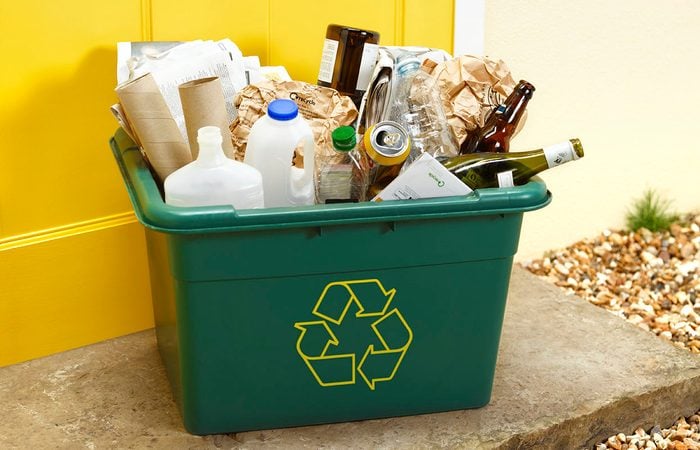What Do Plastic Recycling Numbers Actually Mean?
Updated: Aug. 29, 2023

Understanding those numbers will help make sure you're recycling properly.
We’re surrounded by plastic, in the kitchen, the bathroom and almost everywhere else you look. And while we’re told plastic recycling is easy, that’s not always the case. Some plastic products can easily be tossed into the curbside recycling bin, while others can’t because they pose a hazard to the recycling process.
So how do you know what kind of plastic can and can’t be recycled? It can be confusing, but fortunately, there’s a little code that tells you all your need to know.
On This Page
What Are Resin Identification Codes?
That’s the number from one to seven that’s usually located somewhere on plastic. That number is a code that identifies the type of plastic resin used to create that specific product, according to the American Chemistry Council.
You’ll notice that the number is almost always circled by what looks like a recycling symbol, of arrows following each other in a circular pattern, but don’t let that fool you. Not all plastic is easily recycled. What you want to pay attention to is the number inside the arrows, the resin identification code, which will tell you whether or not it can be recycled.
Those numbers also help workers at the recycling center sort everything that comes in, helping them identify how each batch of materials should be processed.
Recycling Plastic
Before tossing anything into your curbside recycling bin or any other recycling container, it’s essential to check first to see what types of items are accepted, and with plastics, see what numbers the service will take.
Another important reminder for recycling plastic that often gets overlooked is that containers should be empty, clean and dry before they get tossed into the bin. This prevents contamination of other materials being collected in the truck and at the processing center.
That doesn’t mean your plastic bottles have to be cleaned and sanitized in the dishwasher. Most of the time, rinsing them out and letting them dry is sufficient.
#1: Polyethylene terephthalate (PET or PETE)
Chances are there’s lots of polyethylene terephthalate, also known as PET or PETE, sitting in your kitchen right now. This transparent type of plastic is most commonly used for food packaging because of its strength and temperature resistance. It’s also highly shatter resistant.
PET plastic has been cleared by the FDA for repeated use, so you can reuse those old water bottles. However, you need to clean them out thoroughly before refilling them.
You can also recycle PET plastic in your curbside bin. According to the PET Resin Association, it’s accepted almost universally at recycling centers across the country. In fact, it’s the most frequently recycled plastic, in part, because it’s easy to recycle. Among the more common uses for recycled PET is fiber for carpet and clothing.
#2: High Density Polyethylene (HDPE)
If you use liquid laundry detergent, it’s probably in a bottle made of HDPE plastic. In addition to that, it’s also used for milk jugs, and bottles for household cleaning products. It’s also used to make building materials such as pipes and composite wood.
Short for high density polyethylene, you can also think of the “HD” has a mnemonic device for “highly durable.” It’s long lasting and can withstand extreme temperatures. You can reuse HDPE plastics over and over again too. Again, make sure it’s been cleaned before refilling it.
#3: Polyvinyl Chloride (PVC, Vinyl)
Polyvinyl chloride (PVC) is typically found in pipes, medical materials, plastic food wrap, and even records. Lightweight and rigid, it holds up well to weathering and chemicals, oil and grease.
PVC poses risks for human health because over time it can leach harmful chemicals like lead, dioxins, and vinyl chloride. Health care providers and other industries that use PVC have slowly started to move away from it. However, it’s still one of the most common types of plastic found in every day usage.
The chemicals contained in PVC also make it difficult to recycle, requiring an entirely different process. Curbside recycling services typically don’t accept #3 plastics, but there may be special collection centers available. Check with your local provider for specifics in your community.
#4: Low Density Polyethylene (LDPE)
Known as low-density polyethylene (LDPE), plastic 4 is found in many squeeze bottles, toys and food film It’s also used in plastic bags used for dry cleaning, bread and produce bags. It can be reused, though you’ll want to make sure anything that’s been in contact with food is thoroughly cleaned.
This type of plastic isn’t usually accepted in curbside services. Like PVC, there may be special collection points for it, so check with your recycling provider for more information on where to recycle #4 plastics.
#5: Polypropylene (PP)
Polypropylene is durable and resistant to high temperatures, which is why it’s commonly found in takeout containers, as well as medicine bottles, straws and bottle caps. It’s also safe to reuse. In fact, you’re probably already regularly reusing some polypropylene products in your house if you have plastic cutlery or dishes.
Most curbside recycling programs accept this type of plastic.
#6: Polystyrene (PS)
Also known as styrofoam, polystyrene is a versatile plastic that can be made into the familiar foam material (e.g. cups) as well as solid products like the foam packing materials used to protect electronics in the box.
Like PVC, polystyrene can also leach harmful chemicals, and its use in food packaging has been banned in several states and municipalities.
Polystyrene doesn’t break down easily, which is one reason it’s not commonly accepted in curbside recycling services. It’s usually not profitable to recycle either, costing more to recycle than the return it can fetch. Again, there may be specialized collection points in your community for polystyrene.
#7: Miscellaneous
Plastic number 7 is basically a catch-all category. That includes nylon, fiberglass acrylic and other materials. Common items in this category include eye glasses, some electronics, and even hose bags you can use to bake turkeys and the five gallon jugs for the office water cooler.
Because the materials vary so much, it’s hard for curbside services to accept #7 plastics, and often times they’re not recyclable.
There is a subcategory of #7 plastics that’s become more common in recent years.
#7PLA: Compostable plastics
This type of plastic is not recyclable. They’ll contaminate the recycling process because of their different chemical composition and melting temperature, according to the University of Colorado Environmental Center.
Don’t let the compostable label fool you either. This kind of plastic won’t break down in your backyard compost bin. It will break down in industrial composting facilities because it’s made from plant-based starches.
Reusing Plastic
Just because a plastic container is empty doesn’t mean it’s outlived its usefulness. Most of the plastic containers we use at home are made from highly durable materials that were designed to hold up to high levels of wear and tear. In most cases you can reuse your plastic containers, especially anything made from #1, #2 and #5 plastic.
There are an infinite number of ways to repurpose your old plastic containers, whether you’re using old takeout containers to store nails and screws or refilling your laundry soap bottle with more laundry soap (some grocery stores and speciality refill stores offer bulk refills for household and personal care products.)
Can You Recycle Plastic Bags?
Most plastic bags are made from either #2 or #4 plastic. They can be recycled, but they require a separate process, even for #2 which is typically accepted in curbside bins, because they’re so thin they can get caught in the machinery and damage it. The same is true for plastic wraps and films. The good news is that many large retailers have plastic bag collection points where you can take them to be recycled.
